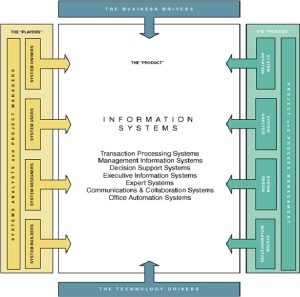The Context of Systems Analysis and Design Methods
Chapter Map
An Information System is a arrangement of people, data, processes and information technology that interact to collect, process, store and provide as output the information needed to support an organization.
Information Technology is contemporary term that describes the combination of computer technology (hardware and software) with telecommunication technology (data, image, and voice network).
From the chapter map, under the Information System has :
A transaction processing system (TPS) is an information system that captures and processes data about business transactions.
A management information system (MIS) is an information system that provides for management-oriented reporting based on transaction processing and operations of the organization.
A decision support system (DSS) is an information system that either helps to identify decision making opportunities or provides information to help make decisions.
An expert system is an information system that captures the expertise of workers and then simulates that expertise to the benefit of nonexperts.
A communications and collaboration system is an information system that enables more effective communications between workers, partners, customers, and suppliers to enhance their ability to collaborate.
An office automation system is an information system that supports the wide range of business office activities that provide for improved work flow between workers.
Stakeholders : Players in the Systems Game.
- A stakeholder is any person who has an interest in an existing or proposed information system. Stakeholders can be technical or nontechnical workers. They may also include both internal and external workers.
- Information workers are those workers whose jobs involve the creation, collection, processing, distribution, and use of information.
- Knowledge workers are a subset of information workers whose responsibilities are based on a specialized body of knowledge.
System owners- an information system’s sponsor and executive advocate, usually responsible for funding the project of developing, operating, and maintaining the information system.
System users – a “customer” who will use or is affected by an information system on a regular basis – capturing, validating, entering, responding to, storing, and exchanging data and information.
- Clerical and service workers
- Technical and professional staff
- Supervisors, middle managers, and executive managers
- Remote and mobile users (internal but disconnected)
System designer – a technical specialist who translates system users’ business requirements and constraints into technical solution. She or he designs the computer databases, inputs, outputs, screens, networks, and software that will meet the system users’ requirements.
System builders – a technical specialist who constructs information systems and components based on the design specifications generated by the system designers.
Systems analyst – a specialist who studies the problems and needs of an organization to determine how people, data, processes, and information technology can best accomplish improvements for the business.
- A programmer/analyst (or analyst/programmer) includes the responsibilities of both the computer programmer and the systems analyst.
- A business analyst focuses on only the nontechnical aspects of systems analysis and design.
- True problem situations, either real or anticipated, that require corrective action
- Opportunities to improve a situation despite the absence of complaints
- Directives to change a situation regardless of whether anyone has complained about the current situation
Where do System Analyst work ?
- Working knowledge of information technology
- Computer programming experience and expertise
- General business knowledge
- General problem-solving skills
- Good interpersonal communication skills
- Good interpersonal relations skills
- Flexibility and adaptability
- Character and ethics
- Globalization of the Economy
- Electronic Commerce and Business
- Security and Privacy
- Collaboration and Partnership
- nowledge Asset Management
- Continuous Improvement and Total Quality Management
- Business Process Redesign


